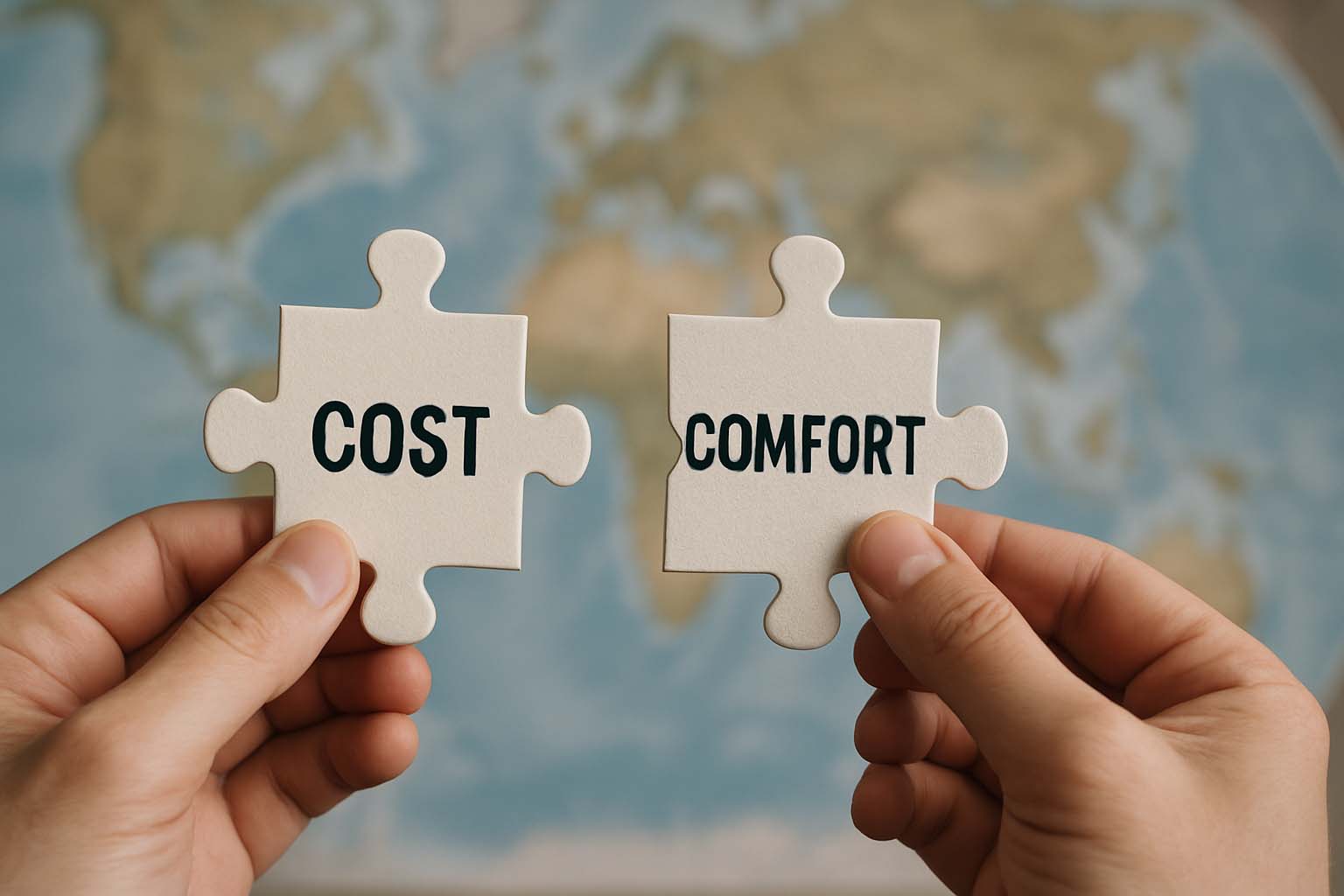Balancing Costs and Comfort When Moving to a New Place
Relocating to a new city or country isn’t just about affordability. Comfort plays a major role — from the quality of housing and transportation to climate and safety. For many families, remote workers, and students searching for better opportunities, one big question stands out: “Is the added cost worth the comfort?”
- Start by researching cost-of-living indexes and average salary data.
- Comfort depends on access to healthcare, transit systems, and safety.
- Use a balanced view of data and personal priorities to guide your move.
- A simple decision matrix can help compare different cities clearly.
Why Balance Matters
According to Numbeo’s 2025 Cost of Living Index, monthly expenses between two cities on the same continent can differ by up to 40%. For instance, the total cost of rent, food, and transport in Valencia can match just the studio rental cost in Amsterdam. But if you want access to the Netherlands’ fast trains and global job network, spending more might be acceptable.
Meanwhile, Zurich, Copenhagen, and Calgary ranked high in the 2024 Global Liveability Report by EIU due to their safety levels and public services. If parks and safety matter to you, you might spend more just to enjoy morning runs or weekend strolls without worry.
Understanding the Real Costs of Moving
Main Living Expenses
Rent or Mortgage – Knight Frank’s data showed a 6% increase in global prime rent in 2024. However, the growth varied. Cities like Austin saw sharp increases, while places like Porto remained stable.
Utilities and Internet – Power bills are higher in Tokyo than in Warsaw, but Tokyo offers cheaper and faster fiber services.
Dining and Entertainment – A meal in a mid-range restaurant costs about CA$25 in Toronto, while Seville offers similar meals at around €13.
Transportation – Consider the price of monthly transit passes or fuel, along with average time spent in traffic.
These figures are often available through government databases. It helps to maintain a monthly spreadsheet during your decision-making process. Including data from trusted aggregators and local websites can increase the accuracy of your projections.
Comfort Beyond the Numbers
Healthcare – Are there hospitals within a 10-kilometer radius? Can you communicate in your preferred language?
Climate – Are you moving from a cold country to a tropical one? Will you be fine with high humidity levels?
Jobs and Income – How much of the local population works in your field? Are there strong hiring trends or industry-specific hubs?
Community – Is there an expat group to help newcomers? Are there weekend programs for parents with kids? Social support systems can ease the early stages of transition and foster belonging.
When you turn these aspects into measurable items, you’ll get a clearer picture of where you can live more comfortably without stretching your budget too far.
Budget Planning Through Data
Let’s compare two remote developers earning US$80,000 per year:
| City | Net Monthly Income | Estimated Monthly Expenses | Savings |
|---|---|---|---|
| Berlin | €3,900 | €2,600 | €1,300 |
| Kuala Lumpur | MYR 18,000 | MYR 8,500 | MYR 9,500 |
The figures show that Kuala Lumpur leaves more in your pocket. However, direct flights to Europe are fewer, and the climate stays warm year-round. If you value mild seasons, Berlin might still be your choice, even with slightly lower savings.
Tip: Build a basic Excel sheet to compare three cities. Adjust exchange rates every quarter. Some locations that once seemed cheaper may become costly due to inflation or currency shifts. Consider also adding a column for potential salary growth over the next two to three years.
Case Studies Across Continents
Lisbon to Oslo
Ana, a data analyst, moved from Lisbon to Oslo for better pay. Her take-home income rose by 45%, but her rent more than doubled. Still, she decided to stay for shorter winter daylight gaps and improved childcare services. She also appreciated the availability of public transit, which allowed her to avoid buying a car.
Sao Paulo to Toronto
Rafael sought global work experience. In Toronto, car insurance costs three times more than in Sao Paulo. But with more reliable public healthcare, his family felt secure, making the added cost manageable. He also noticed smoother interactions with local authorities and easier access to international education options for his children.
Personal Decision Matrix
Create a 5×5 matrix to rate each city by Cost (1–5) and Comfort (1–5). Here’s a sample:
| City | Cost | Comfort | Average |
|---|---|---|---|
| Prague | 3 | 4 | 3.5 |
| Seoul | 4 | 5 | 4.5 |
| Valencia | 2 | 3 | 2.5 |
A higher comfort rating can justify extra expenses if it aligns with long-term goals like career growth or children’s education. You can also create custom categories like air quality, walkability, and language barriers to suit your needs.
Talking to Your Family and Stakeholders
- Children – Check the school system and the number of playgrounds nearby.
- Elderly companions – Consider access to senior healthcare and public elevators.
- Pets – Look for housing and parks that welcome animals.
By doing this, you can avoid surprise costs like private tutoring or pet boarding. You also give your loved ones a stronger sense of stability from the beginning. Take time to discuss your decision as a group, factoring in everyone’s priorities.
Cost-Friendly Relocation Tips
Smart Preparation
Research deeply – Download updated salary reports before taking interviews.
Temporary housing first – Book monthly co-living spaces instead of signing a yearly lease right away.
Sell excess items – Use online platforms to sell what you don’t need, cutting down on shipping costs.
Document scanning – Digitize all important papers. It reduces the need for bulky storage and helps during customs or visa applications.
Following just these steps can reduce your first-year expenses by up to 15%. Careful planning goes a long way when switching to a new environment.
2025 Global Relocation Patterns
Demand is rising for medium-sized European cities thanks to new remote work visa programs. These cities offer a mix of affordability and quality of life that appeals to mobile professionals.
Cities like New York and Berlin are tightening housing regulations, pushing some companies to move their operational teams to cities like Budapest and Tallinn. These changes affect both job seekers and expats looking for better living conditions.
Southeast Asian capitals are offering tax perks to foreign professionals. Still, it’s worth keeping an eye on possible currency risks over time. Always analyze the long-term financial impact, not just the first year.
A Brief Look at Mental Well-Being
Visa applications, packing, and adjusting to new customs come with emotional pressure. The 2024 International Employee Well-Being Survey showed that 37% of migrants experienced mood swings within the first six months. Set aside a self-care budget — whether that’s a gym membership or short weekend getaways — to keep your peace of mind.
Joining language classes, support groups, or volunteer circles can also help with social integration. A small investment in wellness can ease the strain of major change.
Future Budget Reminders
Always save at least three months of living expenses as an emergency buffer. If exchange rates drop or projects end suddenly, you won’t have to rush back home or sell assets under pressure.
Having financial breathing room allows you to focus on settling in, networking, and growing professionally without immediate stress.
Practical Reflection
Relocating is like putting together a two-piece puzzle: one side is cost, the other is comfort. By measuring each city using the same set of criteria while considering your priorities, you can make a decision that supports a long-term, fulfilling lifestyle.



